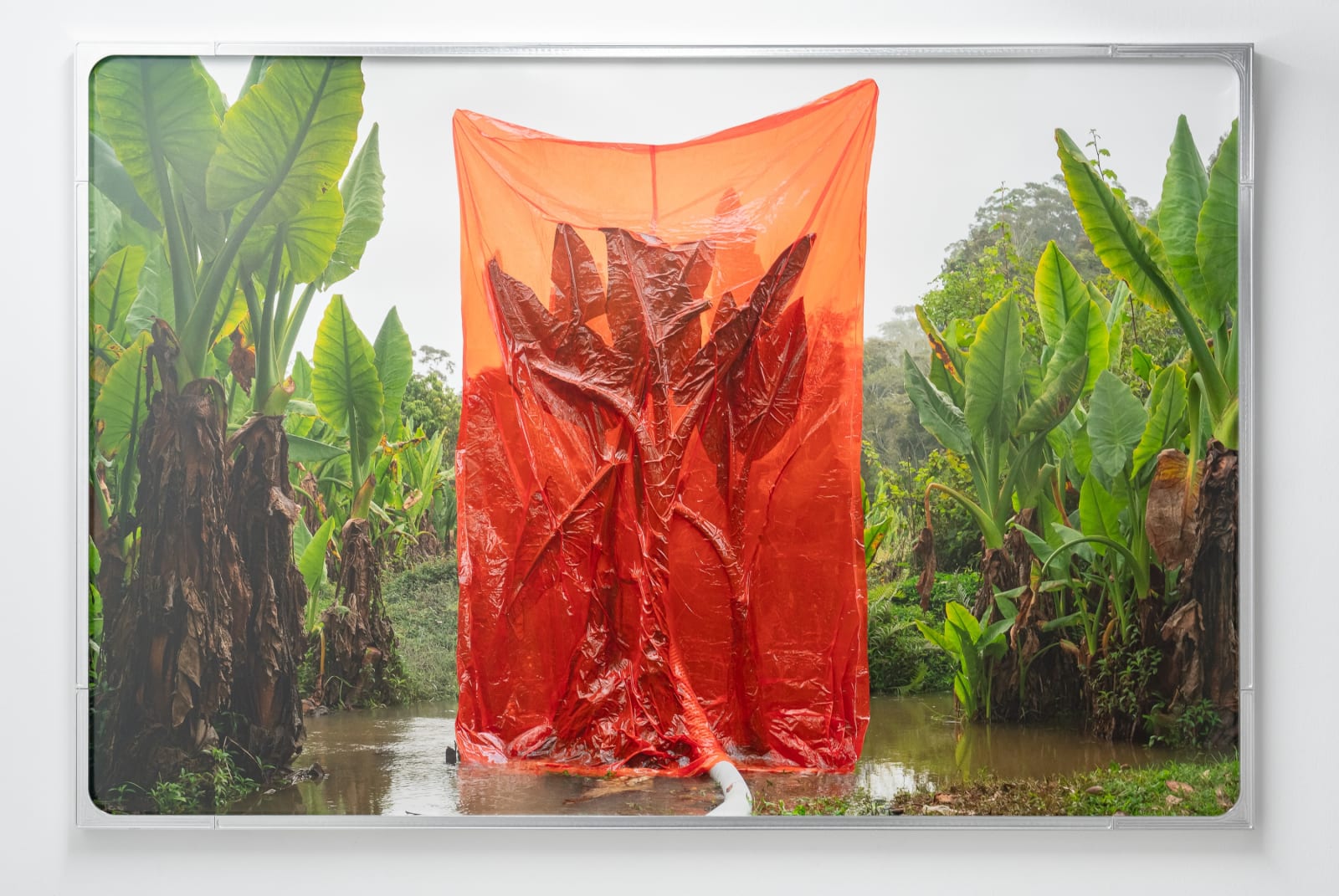Julius von Bismarck
We Were All Naked (Red Elephant Ear), 2023
Archival pigment print on Hahnemühle Photo Rag Baryta
110 x 166 cm
43 1/4 x 65 3/8 inches
43 1/4 x 65 3/8 inches
Ed. 5/6 + 2 AP
Copyright The Artist
Photo: Dirk Tacke
Further images
In der Fotografie „We Were All Naked (Red Elephant Ear)“ (2023) wird eine Bananenpflanze in glänzend-orangen Kunststoff gehüllt und vakuumversiegelt. Die leuchtende Folie umschließt die Pflanze wie eine zweite Haut,...
In der Fotografie „We Were All Naked (Red Elephant Ear)“ (2023) wird eine Bananenpflanze in glänzend-orangen Kunststoff gehüllt und vakuumversiegelt. Die leuchtende Folie umschließt die Pflanze wie eine zweite Haut, die sie aus ihrem natürlichen Kontext herauslöst und in einen Zustand der Bewahrung versetzt, der gleichzeitig ihre Lebendigkeit erstickt. Die Pflanze existiert nun, wie ein konserviertes Mahnmal ökologischer Überformung, in einem Zustand der Unwirklichkeit – konserviert und in eine fremde Existenz überführt, die an die Eingriffe erinnert, die der Mensch der Natur auferlegt. Die Fotografie wurde in Madagaskar aufgenommen, einem der artenreichsten Orte der Erde. Die intensive Farbe der Plastikfolie bildet einen scharfen Kontrast zur Abwesenheit von Leben, die durch die Versiegelung hervorgerufen wird. Wie ein Artefakt in einem Vakuum konserviert, wird die Pflanze zum stummen Zeugen einer Veränderung, die weder rückgängig gemacht noch wirklich verstanden werden kann. In „We Were All Naked (Red Elephant Ear),“ untersucht Julius von Bismarck die Zerbrechlichkeit des Lebens und die Spannungen, die entstehen, wenn menschliche Eingriffe die natürlichen Prozesse unterbrechen. Er verweist auf die oft irreversiblen Auswirkungen menschlicher Technologie auf die Natur. Der menschliche Drang, sich von der Umwelt zu distanzieren und durch Technologie eine Art von Isolation zu schaffen, steht im Gegensatz zu Lebensformen, die sich nicht schnell genug an die sich ständig verändernden, vom Menschen geprägten Bedingungen anpassen können. Die versiegelte Pflanze wird so zum Symbol für die entfremdete Beziehung zur Natur, die gleichzeitig Bewahrung und Verlust bedeutet, sowie die Unmöglichkeit, den natürlichen Kreislauf ohne Folgen zu bewahren.
In the photograph “We Were All Naked (Red Elephant Ear)” (2023), a banana plant is wrapped in glossy orange plastic and vacuum-sealed. The luminous foil encases the plant like a second skin, removing it from its natural context and placing it in a state of preservation that simultaneously suffocates its vitality. The plant now exists as a preserved monument to ecological overexposure, in a condition of unreality—conserved and transferred into a foreign existence that recalls the interventions humans impose on nature.
The photograph was taken in Madagascar, one of the most biodiverse places on Earth. The intense color of the plastic film stands in stark contrast to the absence of life evoked by the vacuum seal. Like an artifact preserved in a vacuum, the plant becomes a silent witness to a transformation that can neither be undone nor fully comprehended.
In “We Were All Naked (Red Elephant Ear)”, Julius von Bismarck explores the fragility of life and the tensions that arise when human interference interrupts natural processes. He points to the often-irreversible impact of human technology on nature. The human urge to distance oneself from the environment and to create a form of isolation through technology stands in opposition to life forms that cannot adapt quickly enough to the constantly shifting, human-shaped conditions.
The sealed plant thus becomes a symbol of our alienated relationship with nature — one that signifies both preservation and loss, as well as the impossibility of maintaining natural cycles without consequences.
In the photograph “We Were All Naked (Red Elephant Ear)” (2023), a banana plant is wrapped in glossy orange plastic and vacuum-sealed. The luminous foil encases the plant like a second skin, removing it from its natural context and placing it in a state of preservation that simultaneously suffocates its vitality. The plant now exists as a preserved monument to ecological overexposure, in a condition of unreality—conserved and transferred into a foreign existence that recalls the interventions humans impose on nature.
The photograph was taken in Madagascar, one of the most biodiverse places on Earth. The intense color of the plastic film stands in stark contrast to the absence of life evoked by the vacuum seal. Like an artifact preserved in a vacuum, the plant becomes a silent witness to a transformation that can neither be undone nor fully comprehended.
In “We Were All Naked (Red Elephant Ear)”, Julius von Bismarck explores the fragility of life and the tensions that arise when human interference interrupts natural processes. He points to the often-irreversible impact of human technology on nature. The human urge to distance oneself from the environment and to create a form of isolation through technology stands in opposition to life forms that cannot adapt quickly enough to the constantly shifting, human-shaped conditions.
The sealed plant thus becomes a symbol of our alienated relationship with nature — one that signifies both preservation and loss, as well as the impossibility of maintaining natural cycles without consequences.
4
of
4









